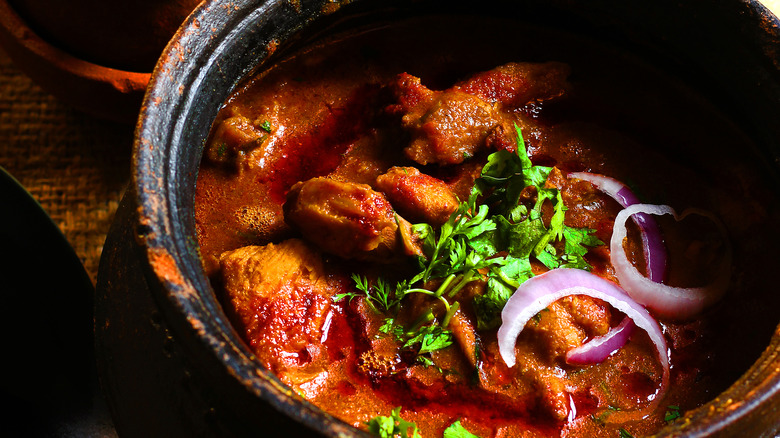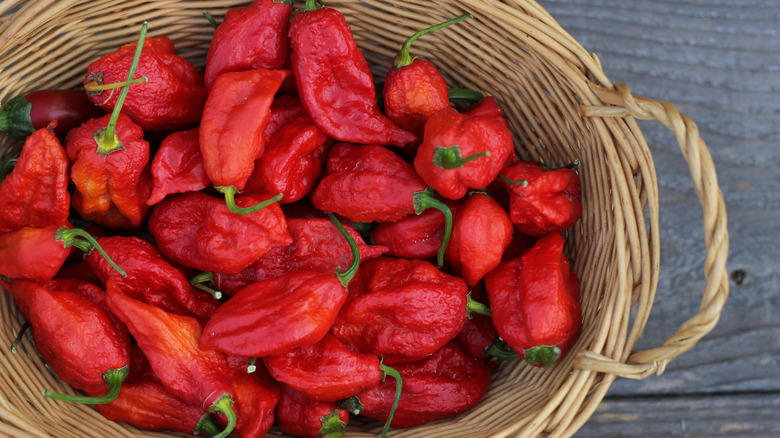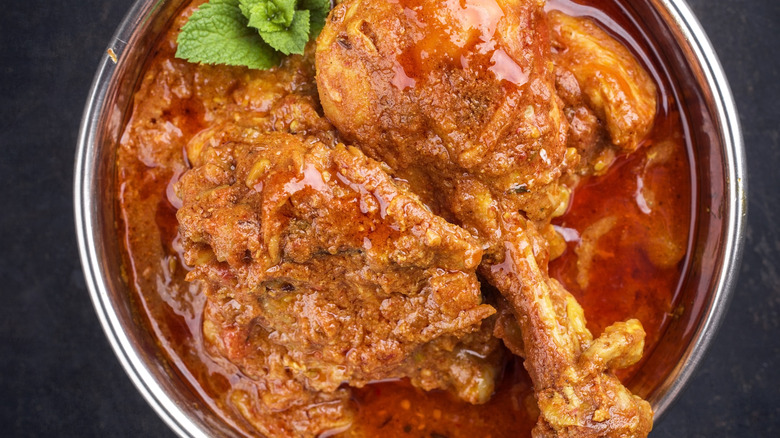Phaal Curry Is The Fiery Dish Only The Bravest Should Try
Looking for the spiciest curry to challenge your taste buds? Phaal curry is our top recommendation, but be warned, it's a dish reserved for only the bravest spice enthusiasts to try. Gordon Ramsay, on the Cookalong Live show, describes phaal curry as "shocking" and the "hottest thing" he has ever eaten. This fiery dish is a fusion creation, tracing its origins to the Bangladeshi-owned restaurants of Birmingham, England, far from the traditional curry hubs of South and Southeast Asia.
According to urban legend, the birth of phaal curry was a response to the demands of curry enthusiasts in Britain. Unsatisfied with the heat of curries like vindaloo, these spice aficionados challenged curry houses to push the boundaries of spiciness. As a result, the British phaal curry was born. Answering the challenge to the next level, curry houses would give out prizes, like beer, to patrons who could finish their plates of phaal curry.
Other spellings of phaal from the U.K. include paal, phall, fall, and phal. In Bangalore, India, there is a different dish also called phaal, but it is not as spicy as this British curry, and it's usually made with mutton or chicken, and eaten as a finger food.
What makes phaal curry so hot?
Phaal curry, with its fiery character and bold flavors, holds a special place in the hearts of spice enthusiasts, as this dish is as unique as it is hot. Some say it's pleasant with a subtle sweetness. Others call it torture; more blood, sweat, and tears than enjoyment. The heat level is quite extreme, fusing South Asian flavors with a British twist. But what makes this curry so spicy? Well, instead of green chiles or standard chili peppers, phaal recipes call for the world's hottest peppers, like ghost peppers (bhut jolokia), scotch bonnets, or habaneros to deliver the heat in a curry sauce made with tomatoes.
All three of these peppers are significantly hotter and spicier than jalapeños. To better understand these peppers' fiery scale, let's compare them with the mild and sweet bell pepper, which has a Scoville Heat Unit (SHU) rating of zero. Jalapeños range from 2,000 to 8,000 SHU. When we get to scotch bonnets, their SHU is around 100,000 to 350,000. Ghost peppers, on the other hand, take the lead at over a million SHU. As such, incorporating ghost peppers into phaal curry elevates the dish to near-mythical status among spice lovers.
The main ingredients that make up the hottest curry in the world
If you're looking to burn your tastebuds at home with some super spicy phaal curry, get your hands on some of the world's hottest peppers. Into a tomato-based sauce these peppers will go, along with sauteed onions and aromatics like garlic and ginger, as well as a blend of South Asian spices like garam masala, coriander, cumin, and turmeric. Any protein, like mutton, tofu, or chicken, can simmer in the curry, absorbing the palate-searing flavors. Plate up and garnish the finished curry with something green, like cilantro or parsley, and add some acidity with a squeeze of lime or lemon juice.
Be careful not to rub your eyes or face at any point when handling the hot peppers at home. And if the prospect of cooking with some of the world's hottest peppers seems daunting, here's an alternative. Many curry houses in cities across New York and the U.K. pride themselves on their phaal curry, so venture out and find a place that serves it. Step into the world of phaal curry and see if you can handle the heat. Maybe you'll end up taking on a challenge and winning a prize, but fair warning, just don't get burned.


